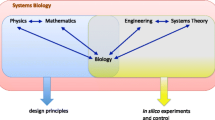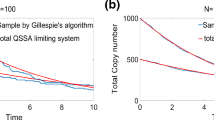Abstract
Macroscopic modeling of biological cell cultures involves two major steps: (a) the selection of a reaction scheme and (b) the determination of the reaction kinetics. The first step is usually accomplished based on prior knowledge, experimental investigation and trials and errors. This procedure can be time consuming, and more importantly, can lead to the selection of a reaction scheme omitting some important reaction pathways, or at the opposite, incorporating too many details (at least considering the data at hand and the modeling objectives). This paper addresses this modeling problem, and aims at the development of a method for systematically evaluating (i.e. setting up and comparing) all potential reaction schemes, based on a set of measured components, and satisfying structural identifiability properties. One of the main features of the method is that the yield (or pseudo-stoichiometric) coefficients can be estimated independently of the kinetics. The method is illustrated with simulation results and an experimental case study.


Similar content being viewed by others
References
Bastin G, Dochain D (1990) On-line estimation and adaptive control of bioreactors. Elsevier, Amsterdam
Bernard O, Bastin G (2004) Identification of reaction networks for bioprocesses: determination of a partially unknown pseudo-stoichiometric matrix. (this issue)
Bogaerts Ph, Delcoux J-L, Hanus R (2003) Maximum likelihood estimation of pseudostoichiometry in macroscopic biological reaction schemes. Chem Eng Sci 58:1545–1563
Bogaerts Ph, Hanus R (2000) Macroscopic modelling of bioprocesses with a view to engineering applications. In: Thonart Ph, Hofman M, (eds) Focus on Biotechnology Vol IV (Engineering and Manufacturing for Biotechnology). Kluwer, Dordercht
Bogaerts Ph, Vande Wouwer A (2001) Systematic generation of identifiable macroscopic reaction schemes. In: Proceedings of the 8th IFAC Conference on Computer Applications in Biotechnology (CAB8). Montreal, Canada
Chen L, Bastin G (1996) Structural identifiability of the yield coefficients in bioprocess models when the reaction rates are unknown. Math Biosci 132:35-67
Haag J, Vande Wouwer A, Bogaerts P (2004) Dynamic modeling of complex biological systems: A link between metabolic and macroscopic description. Math Biosci (in press)
Haag J, Vande Wouwer A, Bogaerts P (2005) Systematic procedure for the reduction of complex biological reaction pathways and the generation of macroscopic equivalents. Chem Eng Sci 60:459-465
Provost A, Bastin G (2004) Dynamic metabolic modelling under the balanced growth condition. J Process Control 14:717-728
Sonnleitner B, Kaeppeli O (1986) Growth of Saccharomyces cerevisiae is controlled by its limited respiratory capacity: formulation and verification of a hypothesis. Biotechnol. Bioeng 28:927-937
Tsuchiya HM, Fredrickson AG, Aris R (1966) Dynamics of microbial cell populations. Adv Chem Eng 6:125-206
Acknowledgements
The authors are very grateful to Prof. A. Jacquet and L. Coulon at the Applied Genetic Department, Université Libre de Bruxelles, Belgium, for providing the experimental data of the CHO-K1 cell cultures used in this contribution.
Author information
Authors and Affiliations
Corresponding author
Appendix
Appendix
A Appendix mass balance equations of a bioreactor operated in perfusion mode
In the developments (Eqs. 4,5,6,7,8,9,10 and 11), it has been assumed that the dilution rate D(t) is a scalar quantity. However, there are situations where a matrix of dilution rates has to be used to represent the operating conditions. For instance, if the bioreactor is operated in perfusion mode and the biomass is retained inside the bioreactor thanks to a filtering device, then the biomass dilution rate is equal to zero. In this case, the partition of the state vector \(\xi^{T}=[\xi_{a}^{T}\;\xi_{b}^{T}]\) induces a partition of the dilution rate matrix \(D^{T}=\left[\begin{array}{ll}D_{a}^{T} & D_{b}^{T}\end{array}\right],\) which prevents the expression of the dynamics of Z independently of the kinetics. This difficulty can be alleviated by introducing a fictitious biomass input (with X in=X) compensating the resulting biomass dilution. This way, the mass balance for the biomass can be written as
which can be cast into the general dynamic model 2 with a scalar dilution rate D. However, this formulation has a drawback. Indeed, whereas the feed concentrations are known (as they are imposed by the operator), the fictitious input X in=X is measured at discrete times only. Rigorously, X(t) should be known in continuous time in order to solve Eq. 11 (DX in(t)=DX(t) being part of u a or u b ). In practice, the continuous signal DX(t) is approximated by smoothing of (noisy) measurements (thus, introducing approximation errors).
B Appendix maximum likelihood estimator of the pseudo-stoichiometric coefficients
On the basis of Eqs. 10 and 11, measurements of ξ a and ξ b , and knowledge of D, u a and u b , it is possible to estimate the matrix C independently of the kinetics. Indeed, the solution of Eq. 11 is given by
which can be substituted into Eq. 10 to obtain the following equation
where
and
. Defining a vector ϑ C containing all the unknown parameters of C and all the initial conditions of the considered experiments (if the data set at hand includes R experiments, each with N r sample times, ϑ C contains the R initial conditions z r (0), r∈[1,R]), Eq. 36 can be written for an experiment r and a time instant t r,k , k∈[1,N r ] under the form
where
and
with C (i,:)the i th row of C.
The maximum likelihood estimation of ϑ C is given by
where
In these expressions, ɛ Y,r,k and ɛφr,k are white measurement noises, normally distributed, with zero mean
and covariance matrices Q Y,r,k and Q φr,k , i.e.,
E representing the mathematical expectation.
An estimation \(\hat {C}\) of the matrix C is included in \(\hat {\vartheta}_{C}\) and, in turn, an estimation \(\hat{K_b}\) of the matrix K b is obtained. An estimation of the covariance matrix of the parameter estimation errors is proposed in ([3, 4]).
It is also possible to show that the most likely values of Y r,k and φ r,k are given by the following relations
with
which allow the determination of the most likely state variable trajectory from Eqs. 40, 39, 37 and 38.
Rights and permissions
About this article
Cite this article
Hulhoven, X., Vande Wouwer, A. & Bogaerts, P. On a systematic procedure for the predetermination of macroscopic reaction schemes. Bioprocess Biosyst Eng 27, 283–291 (2005). https://doi.org/10.1007/s00449-005-0406-4
Received:
Accepted:
Published:
Issue Date:
DOI: https://doi.org/10.1007/s00449-005-0406-4




